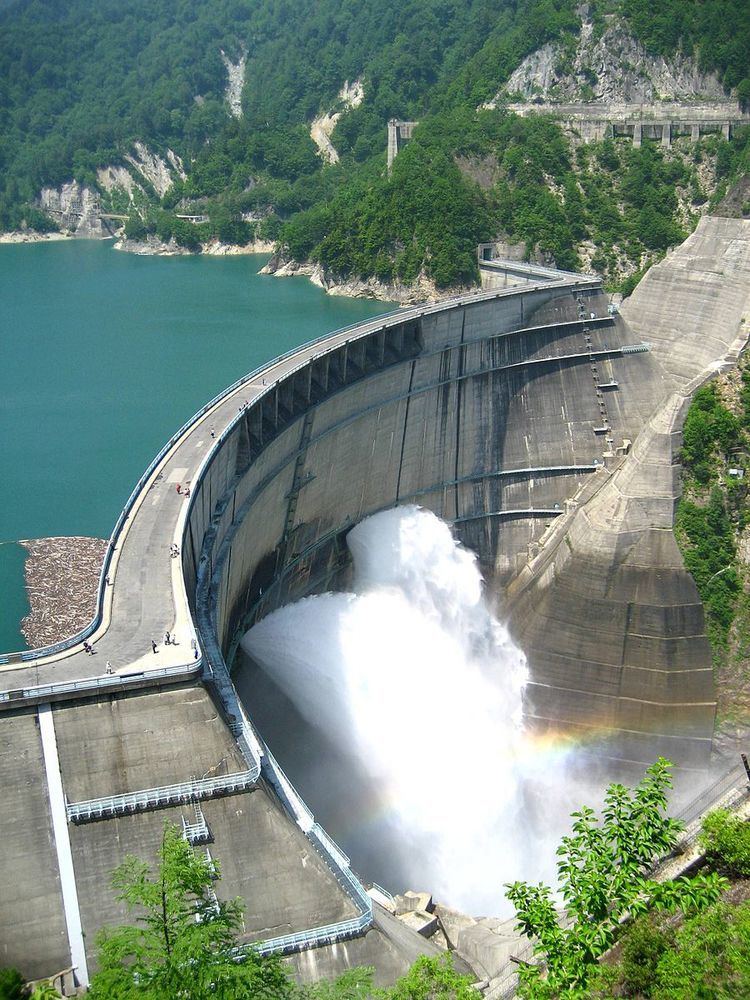Status Operational Opening date 1963 Height 186 m | Purpose Power, water supply Construction began 1956 Opened 1963 Phone +81 261-22-0804 | |
 | ||
Construction cost ¥51.3 billion $142.5 million (1963) Hours Open today · Open 24 hoursSundayOpen 24 hoursMonday(Vernal Equinox Day)Open 24 hoursHours might differTuesdayOpen 24 hoursWednesdayOpen 24 hoursThursdayOpen 24 hoursFridayOpen 24 hoursSaturdayOpen 24 hours Similar Tateyama Kurobe Alpine Ro, Ōgizawa Station, Mount Tate, Kurobedaira Station, Kurobeko Station Profiles | ||
hd kurobe dam toyama japan
The Kurobe Dam (黒部ダム) or Kuroyon Dam (黒四ダム), is a variable-radius arch dam on the Kurobe River in Toyama Prefecture on the island of Honshū, Japan. It supports the 335 MW Kurobe No. 4 Hydropower Plant and is owned by Kansai Electric Power Company. At 186 metres (610 ft) in height, it is the tallest dam in Japan. It was constructed between 1956 and 1963 at a cost of ¥51.3 billion yen. The project was a difficult engineering feat for the rapidly growing post–World War II Japan, and claimed the lives of 171 people.
Contents
Vlog kurobe dam mountain
History
In 1951, the Kansai Electric Power Company was formed to provide electric power for the Kansai region of Japan. Shortly after their formation, the area suffered from drought which caused power rationing. The drought along with the rapid growth of post–World War II Japan pushed the company to increase their generating capacity. After a series of geological and hydrological studies of the Kurobe River and Gorge, it was announced in late 1955 that the Kurobe Dam would be constructed.
In July 1956, construction on the dam began. Problems quickly arose while transporting material to the construction site as only one small railway existed through the narrow gorge. Kansai decided to construct the 5.4 kilometres (3.4 mi) Kanden Tunnel under Mount Tate that could bring supplies from Ōmachi eastward towards the construction site. The tunnel proved an arduous task as a large fracture zone in the rock was encountered which took seven months to repair. In September 1959, the first concrete for the dam was placed and by October of the next year, the reservoir had begun to fill.
The Kurobe No. 4 power station was built completely underground to protect it from common avalanches in the gorge and also for nature conservation purposes. By January 1961, two of Kurobe No. 4's Pelton turbines had begun operation at an initial capacity of 154 MW. In August 1962, the third turbine was in operation and by June 1963, the dam was complete at a final cost of ¥ 51.3 billion ($142.5 million (1963)). In 1973, a fourth turbine was installed and became operational; bringing the power station's production capacity to 335 MW. The fourth turbine cost ¥ 1.4 billion yen ($5 million (1973)). The first two turbines were manufactured by Voith and the second two by Japan's Hitachi. The dam initiated the development of Japan's first 275kV transmission system as well which allowed the transfer of electricity over greater distances. A total of 171 people died during the construction of the dam.
Specifications
The Kurobe Dam is a 492 m (1,614 ft) long and 186 m (610 ft) high, with variable-radius (dome) arch dam. The dam is 39.7 m (130 ft) wide at its base, 8.1 m (27 ft) wide at its crest and contains 1,582,845 m3 (2,070,283 cu yd) of concrete. The dam is flanked and supported by two "wing" dams which form the abutments; the one on the left bank is 69 m (226 ft) long and the right is 56 m (184 ft). The dam withholds a reservoir with a capacity of 199,285,175 m3 (260,655,168 cu yd) of which 148,843,000 m3 (194,679,000 cu yd) is live (active or "useful") storage. The reservoir also has a catchment area of 188.5 km2 (72.8 sq mi) and surface area of 3.49 km2 (1.35 sq mi). The dam's spillway is located on its crest and contains 10 11.5 m (38 ft) wide uncontrolled openings with a maximum discharge capacity of 906 m3/s (32,000 cu ft/s). Three other openings exist in the dam's orifice which consist of 1.5 m (4.9 ft) diameter pipes, two of which can discharge a maximum of 88 m3/s (3,100 cu ft/s) each and the third 44 m3/s (1,600 cu ft/s). The dam's crest elevation is 1,454 m (4,770 ft) above sea level while the reservoir's normal operating level is 1,448 m (4,751 ft) and low level is considered 1,338 m (4,390 ft).
The dam's power station, Kurobe No. 4, is located underground and contains four generators which are powered by Pelton turbines for a total installed capacity of 335 MW and average annual generation of 1 billion kWh. The power station is 22 m (72 ft) wide, 33 m (108 ft) high and 117 m (384 ft) long. The penstock serving water to the power station is 10,909.6 m (35,793 ft) long and utilizes a maximum effective hydraulic head of 545.5 m (1,790 ft) while transferring a maximum of 72 m3/s (2,500 cu ft/s) to the turbines. The plant's surge chamber is 145.6 m (478 ft) long and 5 m (16 ft) high.
In popular culture
The Kurobe Dam is the most popular hydropower site in Japan and, between late June and mid-October, water is released from its spillway for onlookers. The surrounding Kurobe Gorge is also popular as well and is accessible by the Kurobe Gorge Railway. A novel turned film, Kurobe no Taiyō (黒部の太陽; literally "The Sun of Kurobe"), starring Yujiro Ishihara (the late brother of Tokyo governor Shintaro Ishihara), recounts the drama of the project. The P.A.Works's mecha anime television series Kuromukuro is mainly settled in a UN research facility located around the lake, while the NHK television series Project X was also based on the dam's construction.
